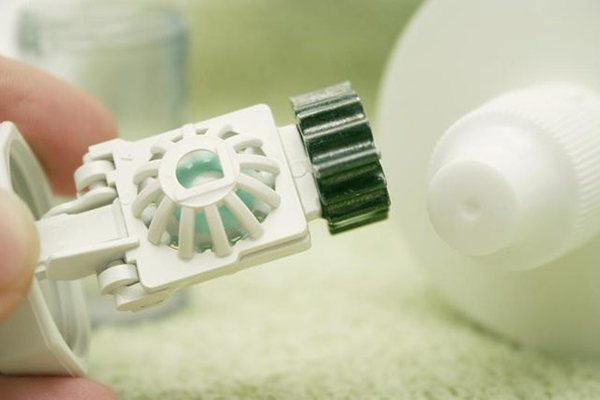Yikes! I Just Increased My Platinum Footprint
By Mark Jones, PhD | August 8, 2016
Category: BLOG_I hadn’t thought much about my platinum footprint until about a month ago. New contact lenses came with new cleaning instructions, a peroxide cleaner, and a plastic container with screw caps on suspended cages to hold the lenses. Below the cages was a black, metallic-looking lobed disk. When the disk is immersed in hydrogen peroxide, bubbles are generated.
BLOG_I hadn’t thought much about my platinum footprint until about a month ago. New contact lenses came with new cleaning instructions, a peroxide cleaner, and a plastic container with screw caps on suspended cages to hold the lenses. Below the cages was a black, metallic-looking lobed disk. When the disk is immersed in hydrogen peroxide, bubbles are generated.
The instructions mention a platinum neutralizing disk. I was pretty sure this was going to be like the time I was offered a “platinum” credit card. It turned out just to be a normal plastic credit card with “platinum” written on it. Could a throwaway disk really be made of platinum? Platinum group metals are, after all, a finite and depletable resource, on most every list of critical metals.
Cornea damage made me pretty blind in one eye, but a contact lens evens out the imperfections, restoring pretty good vision. Glasses are not an option. Peroxide cleaning solutions are very effective at killing pathogens that cause severe eye infections, but they sting like crazy if they get in your eye so they must be “neutralized.” Hydrogen peroxide is catalytically decomposed, neutralized to water and oxygen, creating bubbles. The enzyme tablets that were once used[1] to do this now have replaced with a platinum catalyst disk in all products I found on store shelves.
My new contact cleaner means that I now throw platinum away. That made me realize I have a platinum footprint and it just went up.
Delving Into Platinum as a Resource
Several years ago, I had the pleasure of hearing Paul Chirik of Princeton University at the Sustainable Chemical Manufacturing in a Resource-Limited World session[2]. Chirik, sometimes called a modern alchemist[3], spoke of his work to replace platinum with base metals. Paul just won the Presidential Green Chemistry Challenge for replacing platinum with more abundant metals.[4] Platinum, it seems, is a pretty big deal.
Chirik’s work found catalysts to replace platinum in silicone polymerizations. [5] Many silicones are made by platinum catalyzed reactions. The platinum remains in the silicones, trapped in the rubber, adhesives, and coatings. The platinum in the silicones are at concentrations of less than 100 parts per million (ppm). Recovery is impossible, unlike in heterogeneous applications, like industrial or automotive catalysis, where recovery and recycle are the norm.
After listening to Chirik, I did briefly ponder my own platinum footprint. Based on national consumption, it appears that each of us account for about 90 milligrams (mg) of platinum per year[7]. The largest use of platinum is in automotive catalysts, but it is recycled very effectively and I drive a 2009 car. Next largest use is for jewelry, but I don’t have any platinum jewelry and have never purchased any. Discounting for automotive and jewelry use brings my personal use to about 37 mg per year[7].
Carbon Footprint
My platinum footprint is much less than my greenhouse gas (GHG) footprint. That is a whopping 27.25 tons of carbon dioxide[8] (CO2). I do take steps to manage my carbon footprint. I buy clean energy, drive a hyper-efficient car and avoid eating red meat. I actively try to conserve energy. I know which activities increase my carbon footprint. Yet, in spite of all my efforts, it is tough to reduce my footprint by even 10 percent.
My GHG footprint and my platinum footprint are similar in that they both represent about a part-per-trillion of the global yearly consumption of the respective resources. It probably shouldn’t come as a surprise that my participation in a developed economy dominates my use of both the earth’s fossil carbon reserves and its platinum reserves.
Why Platinum?
Using platinum to neutralize peroxide is remarkably puzzling. Any number of reports on critical materials list platinum as one of the most critical[9],[10]. It has applications where no viable substitute exists. It is expensive–historically the most expensive precious metal–but currently second to gold. Current price is about $870 per troy ounce ($28 per gram), with a 10-year average price over $1,215 per troy ounce[11].
The neutralizing disk is a heterogeneous catalyst. Platinum used in heterogeneous catalysts for chemical processing are recycled. That is the beauty of heterogeneous catalysts; the catalytic materials stay put. Although the platinum stays on the disk to be used multiple times, even the best catalysts deactivate and, because deactivation could lead to a painful eye, monthly replacement is dictated.
The platinum on each disk is around 600 micrograms[12], covering a plastic support weighing about 0.8 grams[13]. The platinum on the disk is worth less than two cents worth at current prices, or about 20 cents for a year’s worth. A lot of people wear contact lens wearers: almost 41 million in the U.S.[14]. About 93 percent now wear soft contacts14 and recent data indicates that 20 percent use peroxide cleaners[15]. Contacts users trash 1,700 troy oz. of platinum with a value of over $1.5 million per year. As for my platinum footprint, the monthly disk change just increased my platinum footprint by about 15 percent.
There are several ways to look at this. The platinum concentration in the disks is more than 600 times greater than the concentration of high-quality platinum ore[16] that exists in this country. Platinum is a critical material. Wasting it just feels wrong. The precious metal is commonly recycled today from automotive, jewelry and catalysis applications.
On the other hand, the total use for contact cleaning is less than 0.2 percent of the U.S. platinum demand. The disks are small, making recovery a bit of a challenge from mixed streams and, while at higher concentration than in ore, the concentration on the disk is a measly 750 micrograms per gram.
Recycling Possibilities?
I actually pay to have my recycling picked up. That tells me that the value of the materials being recycled is low. Magazines and newspapers are worth only about 0.6 cents[17]. Steel cans and polyethylene terephthalate (PET) water bottles are about 0.2 cents[18]. Only a high-density polyethylene (HDPE) milk jug, at about 4 cents[19], topped the 1.6 cents worth of platinum in the disk. So, from a value standpoint, it seems that recycling the platinum disks should work. There is already a robust reclamation infrastructure in place for automotive and industrial use. In California, I encountered single-stream recycling of cork in recycling bins at a grocery store. Could that be a model for platinum?
I am also mystified as to why platinum is being used in this application at all. Why were homogeneous enzymes replaced with heterogeneous platinum in contact lens care? Was it to eliminate the possibility that forgetful users would fail to introduce the enzyme? The platinum disk attached to the contact case is pretty fool-proof.
Still, a rich literature exists on immobilizing enzymes, including peroxidases derived from a number of plant and fungal sources. I can’t find a reason why immobilized enzymes wouldn’t work for neutralization. Too, many metals less expensive than platinum decompose peroxide, including supported catalysts based on iron and copper.
I would like to reduce my platinum footprint; doing away with the neutralizing disk in my contact cleaner would have a big impact.
I wish a 15 percent decrease in my carbon footprint were as easy to do.
Notes:
[1] Christie, Caroline L., and John G. Meylerr. “Contemporary contact lens care products.” Contact Lens and Anterior Eye 20 (1997): S11-S17.
[2] AAAS 2013 Annual Meeting, Boston, MA. https://aaas.confex.com/aaas/2013/webprogram/Session5665.html
[3] Paul’s talk was titled ‘Modern Alchemy for Industrial Commodity Chemical and Pharmaceutical Synthesis”
[4] https://aaas.confex.com/aaas/2013/webprogram/Paper8466.html
[4] https://www.epa.gov/greenchemistry/presidential-green-chemistry-challenge-2016-academic-award downloaded on 3 August 2016.
[5] Lewis, Larry N.; Stein, Judith; Gao, Yan; Colborn, Robert E.; Hutchins, Gudrun; “Platinum Catalysts Used in the Silicones Industry”, Platinum Metals Review 41 (1997): 66-74.
[6] using 29,800 kg of Pt demand for North America from the Johnson Matthey PGM Market Report for November 2015 and 318.9 million people in the U.S. from the 2014 World Bank statistics
[7] Using Pt demand for North America from the Johnson Matthey PGM Market Report for November 2015 and subtracting automotive, investment and jewelry
[8] calculated for my zip code using the methods of Jones and Kammen (ones, Christopher, and Daniel M. Kammen. “Spatial distribution of U.S. household carbon footprints reveals suburbanization undermines greenhouse gas benefits of urban population density.” Environmental science & technology 48, no. 2 (2014): 895-902.) from the coolclimate.berkeley.edu/carboncalculator and splitting the household footprint by occupants.
[9] National Research Council (NRC) Committee on Critical Mineral Impacts of the U.S. Economy, Committee on Earth Resources; “Minerals, Critical Minerals, and the U.S. Economy”, National Academies Press, 2008, ISBN 978-0-309-11282-6
[10] US Department of Energy (DOE); “Critical Materials Strategy”, December 2010.DOI: 10.2172/1000846
[11] data from http://www.platinum.matthey.com/ on 16 January 2016.
[12] Kasey Jon Minick, Manal M. Gabriel, Leroy Wainaina Muya, Walter Lee Nash, George Edward Minno (Novartis); WO 2011062959 A1, “A hydrogen peroxide solution and kit for disinfecting contact lenses”, published 26 May 2011 (filed 17 November 2010).
[13] average weight of disks from Alcon Clear Care, Equate and Bausch+Lomb PeroxiClear.
[14] Cope, Jennifer R., Sarah A. Collier, Maya M. Rao, Robin Chalmers, G. Lynn Mitchell, Kathryn Richdale, Heidi Wagner et al. “Contact lens wearer demographics and risk behaviors for contact lens-related eye infections—United States, 2014.” Morbidity and Mortality Weekly Report (MMWR) 64(32), 21 August 2015, pages 865-870.
[15] Chalmers, Robin; “A Fresh Look at One-Step Hydrogen Peroxide Lens Disinfection”, Review of Opt. Published August 2014. (Supplement, reprint CCS14015AEi).
[16] 10 and 40 tonnes of ore must be processed to obtain a single ounce of platinum – See more at: http://www.platinum.matthey.com/about-pgm/production/south-africa#sthash.fj9udWqU.dpuf
[17] based on average measured weight of the Wall Street Journal and data provided from http://waste360.com/commodities-pricing/what-latest-moves-post-consumer-recyclable-materials-prices-tell-us
[18] based on average measured weights of steel cans and water bottles using pricing from http://waste360.com/commodities-pricing/what-latest-moves-post-consumer-recyclable-materials-prices-tell-us
[19] measured weight of a single 1-gallon HDPE milk jug using pricing from http://waste360.com/commodities-pricing/what-latest-moves-post-consumer-recyclable-materials-prices-tell-us

Side by side, we move metal fabrication forward.
FMA unites thousands of metal fabrication and manufacturing professionals around a common purpose: to shape the future of our industry, and in turn shape the world.
Learn More About FMA


